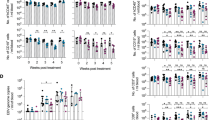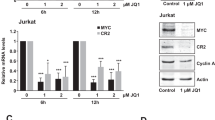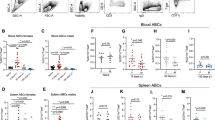Abstract
EPSTEiN-Barr virus (EBV), a human herpesvirus, establishes a persistent asymptomatic infection of the circulating B-lymphocyte pool1–3. The mechanism of virus persistence is not understood but, given the limited lifespan of most B cells in vivo, it seems most likely that EBV-infected cells must gain access to the long-lived memory B-cell pool. Here we show in an in vitro system that EBV, through expression of the full set of eight virus-coded 'latent' proteins, can protect human B cells from programmed cell death (apoptosis), the deletion mechanism which normally restricts entry into memory4. We have found that EBV-positive Burkitt's lym-phoma (BL) cell clones5 retaining the original tumour cell phenotype and expressing only one of the virus latent proteins, the nuclear antigen EBNA 1, are extremely sensitive to apoptosis; in this respect they resemble the tumour's normal cell of origin found in the germinal centres of lymphoid tissue. By contrast, isogenic BL cell clones which have activated expression of all eight EBV latent proteins are resistant to the induction of apoptosis. The EBV latent proteins should therefore be seen not just as activators of B-cell proliferation but, perhaps more importantly, as mediators of enhanced B-cell survival.
This is a preview of subscription content, access via your institution
Access options
Subscribe to this journal
Receive 51 print issues and online access
$199.00 per year
only $3.90 per issue
Buy this article
- Purchase on SpringerLink
- Instant access to full article PDF
Prices may be subject to local taxes which are calculated during checkout
Similar content being viewed by others
References
Nilsson, K., Klein, G., Henle, W. & Henle, G. Int. J. Cancer 8, 443–450 (1971).
Gratama, J. W. et al. Proc. natn. Acad. Sci. U.S.A. 85, 8693–8696 (1988).
Yao, Q. Y., Ogan, P., Rowe, M., Wood, M. & Rickinson, A. B. Int. J. Cancer 43, 67–71 (1989).
Liu, Y-J. et al. Nature 342, 929–931 (1989).
Gregory, C. D., Rowe, M. & Rickinson, A. B. J. gen. Virol. 71, 1481–1495 (1990).
Rowe, M. et al. Int. J. Cancer 35, 435–442 (1985).
Rooney, C. M. et al. J. natn. Cancer Inst. 77, 681–687 (1986).
Rowe, M. et al. EMBO J. 6, 2743–2751 (1987).
Wyllie, A. H. Int. Rev. Cytol. 68, 252–305 (1981).
Wyllie, A. H. Nature 284, 555–556 (1980).
McConkey, D. J., Orrenius, S. & Jondal, M. Immun. Today 11, 120–121 (1990).
Smith, C. A., Williams, G. T., Kingston, R., Jenkinson, E. J. & Owen, J. J. T. Nature 337, 181–184 (1989).
Wyllie, A. H., Morris, R. G., Smith, A. L. & Dunlop, D. J. Path. 142, 67–77 (1984).
Calender, A. et al. Proc. natn. Acad. Sci. U.S.A. 84, 8060–8064 (1987).
Berard, C. W. in Burkitt's Lymphoma: A Human Cancer Model IARC Scient. Pub. No. 60 (eds Lenoir, G., O'Connor, G. & Olweny, C. L. M.) 31–35 (IARC, Lyon, 1985).
Mann, R. B. et al. New Engl. J. Med. 295, 685–691 (1976).
Gregory, C. D. et al. J. Immun. 139, 313–318 (1987).
MacLennan, I. C. M., Liu, Y-J., Oldfield, S., Zhang, J. & Lane, P. J. L. Curr. Topics microbiol. immun. 159, 37–63 (1990).
Pennell, C. A. & Scott, D. W. Eur. J. Immun. 16, 1577–1581 (1986).
Hasbold, J. & Klaus, G. G. B. Eur. J. Immun. 20, 1685–1690 (1990).
Yates, J., Warren, N., Reisman, D. & Sugden, B. Proc. natn. Acad. Sci. U.S.A. 81, 3806–3810 (1984).
McConkey, D. J., Hartzell, P., Duddy, S. K., Hakansson, H. & Orrenius, S. Science 242, 256–258 (1989).
Arends, M. J., Morris, R. G. & Wyllie, A. H. Am. J. Path. 136, 593–608 (1990).
Author information
Authors and Affiliations
Rights and permissions
About this article
Cite this article
Gregory, C., Dive, C., Henderson, S. et al. Activation of Epstein–Barr virus latent genes protects human B cells from death by apoptosis. Nature 349, 612–614 (1991). https://doi.org/10.1038/349612a0
Received:
Accepted:
Issue Date:
DOI: https://doi.org/10.1038/349612a0
This article is cited by
-
Molecular Mechanisms of Severe Diseases Caused by Epstein-Barr Virus Infection
Current Clinical Microbiology Reports (2023)
-
Unravelling the first key steps in equine herpesvirus type 5 (EHV5) pathogenesis using ex vivo and in vitro equine models
Veterinary Research (2019)
-
Coordinated repression of BIM and PUMA by Epstein–Barr virus latent genes maintains the survival of Burkitt lymphoma cells
Cell Death & Differentiation (2018)
-
Apoptosis-induced activation of HIV-1 in latently infected cell lines
Retrovirology (2015)
-
Epstein Barr virus: a prime candidate of breast cancer aetiology in Sudanese patients
Infectious Agents and Cancer (2014)



